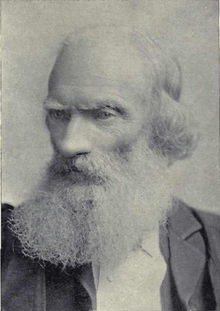Daniel Wilson (academic)
| Sir Daniel Wilson | |
|---|---|
 | |
| 3rd President of the University of Toronto | |
| In office 1880–1892 | |
| Preceded by | John McCaul |
| Succeeded by | James Loudon |
| Personal details | |
| Born | January 5, 1816 Edinburgh, Scotland |
| Died | August 6, 1892 (aged 76) Toronto, Ontario |
Sir Daniel Wilson (January 5, 1816 – August 6, 1892) was a Scottish-born Canadian archaeologist, ethnologist and author.
Biography
Wilson was born in Edinburgh and educated at the Royal High School. As a young man, he went to London,[1] and worked in the studio of J. M. W. Turner. His skills as a water-colour painter came back into play much later in his career.[2]
Wilson returned to Edinburgh in 1842, and was appointed Secretary of the Society of Antiquaries of Scotland in 1845.[1] He corresponded with Christian Jürgensen Thomsen and J. J. A. Worsaae, who had established the exhibition of the prehistoric material in the Danish national museum in Copenhagen in terms of the Three-age System – the succession of a Stone Age by a Bronze Age and an Iron Age. He organized the display of the Society's museum after the same chronological scheme, the first to emulate the Copenhagen museum.[2]
In 1848 Wilson published Memorials of Edinburgh in the Olden Time, of which the chief value lies in the numerous illustrations, done by himself [1] It was an important record of the many historic buildings that were at risk or were being lost in the rapid development of central Edinburgh.[citation needed] In 1851 he published The Archaeology and Prehistoric Annals of Scotland,[1] which introduced the word prehistoric into the English archaeological vocabulary – he probably translated it from the Danish word "forhistorie" as used by Thomsen and Worsaae.[citation needed]
In 1853 Wilson left Scotland to take up the post of Professor of History and English Literature in Toronto.[1] In addition to his teaching duties, he kept up his interests in natural history, geology, and was very interested in the ethnography of the indigenous groups that he encountered on his vacation treks. Many of his watercolour sketches of landscapes and encampments of hunter-gatherer groups are now in the Canadian national archives in Ottawa.[citation needed] His brother George Wilson had become the first director of a new national museum in Edinburgh (now the National Museums of Scotland), and Daniel Wilson actively collected ethnographic material for the museum by means of an extensive network of contacts.[citation needed] He was the author of Civilisation in the Old and the New World, and a number of other books, for example, a study on Thomas Chatterton, and Caliban, the Missing Link.[2]
Daniel Wilson served as president of University College, Toronto from 1880 to 1892,[citation needed] and as the first president of the federated University of Toronto from 1890–1892.[1] He asserted their claims against the sectarian universities of the province which denounced the provincial university as godless, and against the private medical schools in Toronto. He advocated what he called "the maintenance of a national system of university education in opposition to sectarian or denominational colleges".[1] He opposed the federation of colleges,[1] particularly that of Victoria College, as a "Methodist plot".[2]
In 1888 Wilson was knighted for his services to education in Canada, and in 1891 given the freedom of the city of Edinburgh. He died in Toronto on August 6, 1892.[1] The Sir Daniel J. Wilson Residence at the University College in University of Toronto is named in his honor.
Notes
References
- Halpenny, Francess G, ed. (1990). "Wilson, Sir Daniel". Dictionary of Canadian Biography. XII (1891–1900) (online ed.). University of Toronto Press.
 Grant, William Lawson (1911). "Wilson, Sir Daniel". In Chisholm, Hugh. Encyclopædia Britannica 28 (11th ed.). Cambridge University Press. p. 691
Grant, William Lawson (1911). "Wilson, Sir Daniel". In Chisholm, Hugh. Encyclopædia Britannica 28 (11th ed.). Cambridge University Press. p. 691
Further reading
- Hulse, Elizabeth (ed.), Thinking with both hands: Sir Daniel Wilson in the old world and the new. Toronto & London, University of Toronto Press, 1999.
- Cousin, John William (1910). "
 Wilson, Sir Daniel". A Short Biographical Dictionary of English Literature. London: J. M. Dent & Sons. Wikisource
Wilson, Sir Daniel". A Short Biographical Dictionary of English Literature. London: J. M. Dent & Sons. Wikisource
External links
| Professional and academic associations | ||
|---|---|---|
| Preceded by Thomas Sterry Hunt |
President of the Royal Society of Canada 1885–1886 |
Succeeded by Thomas-Étienne Hamel |
| Professional and academic associations | ||
|---|---|---|
| Preceded by Sir William Edmond Logan |
President of the Royal Canadian Institute | Succeeded by Sir John Henry Lefroy |
| |||||
|